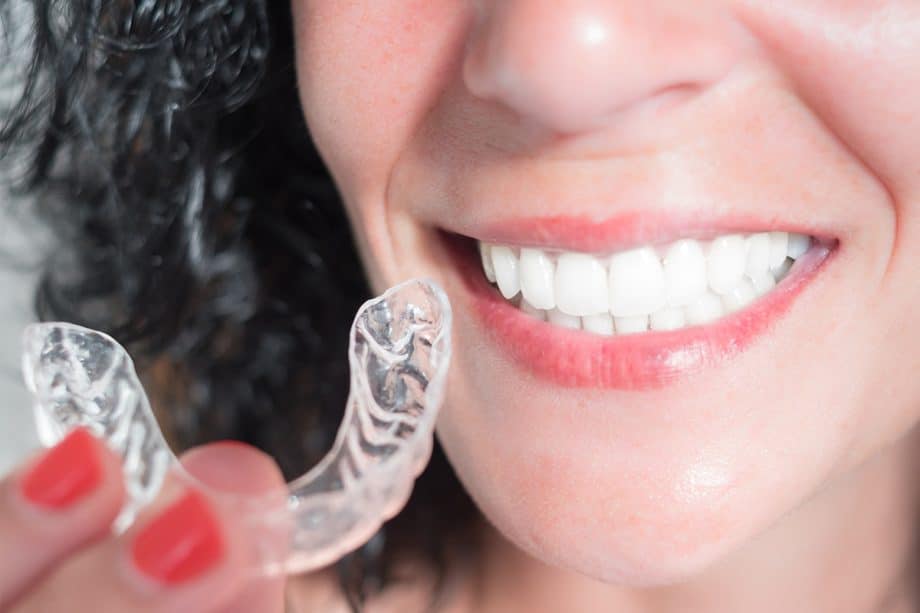When most people think about Invisalign, they picture clear aligners that gently shift teeth without the metal brackets and wires of traditional braces. While this is true, many patients don’t realize that attachments—small, tooth-colored shapes bonded to the teeth—are often an important part of treatment. These attachments give the aligners extra grip and precision, helping to guide teeth into their proper positions more efficiently.
At Hass Family Orthodontics, we believe that understanding your treatment helps you feel more confident and motivated along the way. That’s why we’ve put together this guide to the seven most common Invisalign attachments you might need and what they do.
1. Rectangular Attachments for Rotation
Sometimes teeth, especially canines or premolars, are rotated out of alignment. To correct this, we may place small rectangular attachments on the tooth’s surface. These act like handles for the aligner, giving it the leverage it needs to rotate the tooth into the correct position.
Without these attachments, the aligner may simply slide over the tooth instead of moving it effectively. By adding just a little extra surface area and grip, rectangular attachments ensure your aligners can apply steady, precise pressure.
2. Elliptical Attachments for Extrusion
Some teeth need to be gently pulled downward—or “extruded”—so they sit evenly with the rest of your smile. Elliptical attachments are commonly used for this type of movement. Their rounded shape allows the aligner to apply pressure in a way that carefully lifts the tooth into alignment.
This technique is beneficial when a front tooth appears shorter than the others or doesn’t fully touch the bite line. Elliptical attachments help create a uniform smile that looks and feels balanced.
3. Beveled Attachments for Intrusion
In some cases, certain teeth sit too far down compared to their neighbors. To correct this, we use beveled attachments that guide the aligner in pushing a tooth upward into its proper place. This process is called “intrusion.”
By helping intrude over-erupted teeth, these attachments make the bite more comfortable and prevent uneven wear. They’re particularly valuable in cases where a single tooth throws off the alignment of the bite.
4. Optimized Attachments for Complex Movements
Not every tooth movement is simple, which is why Invisalign has developed optimized attachments; custom shapes created by advanced software to address specific challenges. These attachments may look different from the typical rectangular or round designs and are tailored to the tooth and movement required.
Optimized attachments are often used for root control, bite corrections, or multi-directional movements. They represent how far digital planning and modern Invisalign technology have come in making aligner therapy more effective.
5. Attachments for Root Control
Aligning the crown of the tooth is important, but so is guiding the root. Attachments designed for root control give aligners more precision in moving the entire tooth, not just the visible part above the gumline.
These attachments help prevent relapse or improper movement that could cause instability in the long term. By ensuring the root is correctly positioned, we protect both the aesthetics of your smile and the overall health of your bite.
6. Attachments for Bite Correction
Invisalign isn’t just for cosmetic alignment—it can also be used to correct bite issues. Attachments placed strategically can give aligners the leverage to move upper and lower teeth into a healthier relationship.
These attachments may be used alongside elastics for overbites, underbites, or crossbites. Together, they provide the power and precision needed to improve both function and appearance, often avoiding the need for more invasive orthodontic approaches.
7. Attachments for Space Closure
If you have gaps between your teeth, Invisalign can help close them. Attachments for space closure ensure the aligners don’t just slide along the teeth but actually pull them closer together.
These attachments are designed to create the kind of resistance and grip necessary to shift teeth horizontally. The result is a fuller, more even smile with fewer visible gaps.
Building Confidence Through Understanding
Attachments may seem like small details, but they play a significant role in the effectiveness of Invisalign treatment. They give aligners the extra control needed for complex movements, ensuring faster progress and better results. For most patients, attachments are discreet and barely noticeable, blending with the natural color of your teeth.
At Hass Family Orthodontics, we customize every treatment plan based on your unique smile goals. Whether you need a few simple rotations or multiple attachments for bite correction, our goal is always to give you a healthy, confident smile with the convenience and comfort of Invisalign.
Frequently Asked Questions About Invisalign
Are Invisalign attachments noticeable?
Attachments are made of tooth-colored resin, so they blend in with your natural teeth. While they may feel slightly raised when you run your tongue over them, they are generally not noticeable to others.
Will I need attachments for my entire treatment?
Not always. Some patients only need a few attachments for part of their treatment, while others may need them for the duration. We’ll review your customized plan and explain which attachments are necessary to achieve the best results.
At Hass Family Orthodontics, we love helping patients achieve beautiful smiles with advanced treatments like Invisalign. We proudly serve families throughout our community with personalized orthodontic care in a welcoming environment. Contact us today to schedule a consultation and find out if Invisalign with attachments is right for you.

